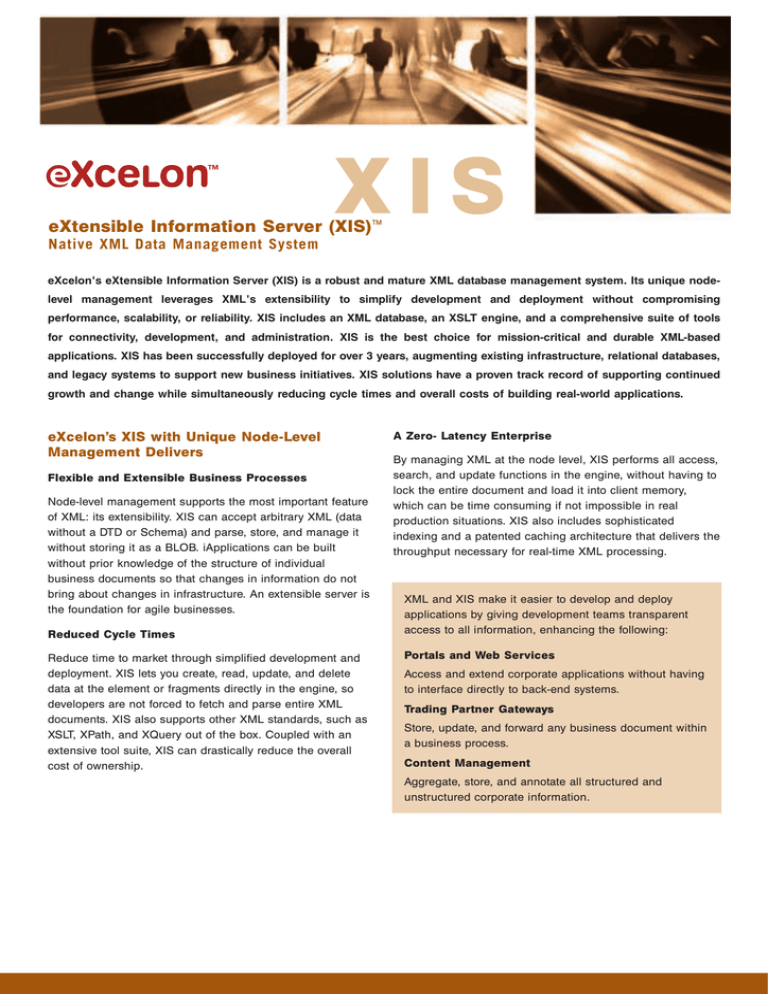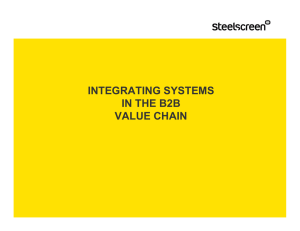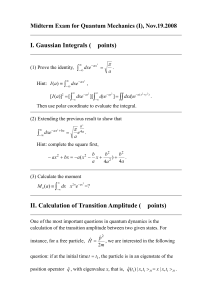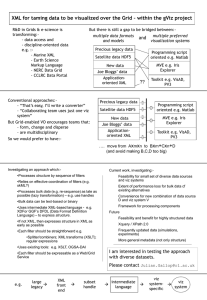X I S eXtensible Information Server (XIS)™ Native XML Data Management System
advertisement

XIS eXtensible Information Server (XIS)™ Native XML Data Management System eXcelon's eXtensible Information Server (XIS) is a robust and mature XML database management system. Its unique nodelevel management leverages XML's extensibility to simplify development and deployment without compromising performance, scalability, or reliability. XIS includes an XML database, an XSLT engine, and a comprehensive suite of tools for connectivity, development, and administration. XIS is the best choice for mission-critical and durable XML-based applications. XIS has been successfully deployed for over 3 years, augmenting existing infrastructure, relational databases, and legacy systems to support new business initiatives. XIS solutions have a proven track record of supporting continued growth and change while simultaneously reducing cycle times and overall costs of building real-world applications. eXcelon’s XIS with Unique Node-Level Management Delivers Flexible and Extensible Business Processes Node-level management supports the most important feature of XML: its extensibility. XIS can accept arbitrary XML (data without a DTD or Schema) and parse, store, and manage it without storing it as a BLOB. iApplications can be built without prior knowledge of the structure of individual business documents so that changes in information do not bring about changes in infrastructure. An extensible server is the foundation for agile businesses. Reduced Cycle Times Reduce time to market through simplified development and deployment. XIS lets you create, read, update, and delete data at the element or fragments directly in the engine, so developers are not forced to fetch and parse entire XML documents. XIS also supports other XML standards, such as XSLT, XPath, and XQuery out of the box. Coupled with an extensive tool suite, XIS can drastically reduce the overall cost of ownership. A Zero- Latency Enterprise By managing XML at the node level, XIS performs all access, search, and update functions in the engine, without having to lock the entire document and load it into client memory, which can be time consuming if not impossible in real production situations. XIS also includes sophisticated indexing and a patented caching architecture that delivers the throughput necessary for real-time XML processing. XML and XIS make it easier to develop and deploy applications by giving development teams transparent access to all information, enhancing the following: Portals and Web Services Access and extend corporate applications without having to interface directly to back-end systems. Trading Partner Gateways Store, update, and forward any business document within a business process. Content Management Aggregate, store, and annotate all structured and unstructured corporate information. Technical Components and Capabilities Java API and JCA Resource Caching Distributed XML Caching Transaction Manager XConnects Transform Cache Manager Query Storage Manager Update User Manager Java Virtual Machine (JVM) Data Sources of Packaged Applications Stored Procedures and Triggers Tools Stylus Studio • Design • Develop DXE Manager • Browse • Configure XConnects • Map Designer • Content Extractor (optional) Node Level Indexing Native XML Storage XConnects for back end connectivity, Dynamic XML Engine (DXE) for runtime support, and XIS tools for visual development and deployment. XConnects XConnects transforms data and content from legacy sources into another XML document type for use with the out-of-the- into standard XML so that all information can be leveraged. box adaptors. XConnects includes native connectors for over 100 different structured and unstructured sources as well as a flexible toolkit for developing custom adaptors. Features include Content Extractor (Optional) – This visual tool generates custom mappings for unstructured data sources such as mainframe screens, word processing documents, and Out of the Box adaptors – XIS supports relational databases, industry-specific formats like HL7 and DIALOG, mainframe systems such as CICS, file-based formats like Paradox and Clipper, enterprise resource planning systems like SAP, HTML files into structured XML data files. Java APIs – These APIs easily embed the transformation engine into applications to automate the process. groupware systems like Lotus Notes, and many more. Scripting Support – This scripting language, based on Specialised integrated connectivity solutions are also available Microsoft Visual Basic, lets you develop complex data from eXcelon business partners. scrubbing and record flow control rules. Scalable Record Management – Scalable data parsing and Support for DTD and XML Schema – You can easily map record access data into existing structural definitions to improve integration of and conversion, even for systems containing millions of records. content into your common information model. DXE supports management provide efficient data Map Designer – This visual tool defines mappings from backend sources into XML and the reverse. They also map XML validation against both DTDs and XML Schemas that conform to the W3C XML Schema 1.0 standard. Dynamic XML Engine (DXE) DXE is the core of XIS and provides node level management of XML data. Node level management reduces development time, increases throughput, and supports XML’s extensibility. DXE provides a scalable, high-performance data management Indexing – With DXE, you can index individual XML elements or groups of elements to accelerate access to relevant data. DXE supports both value indexes for element and attribute comparison searching and word indexing for text searches within document nodes. solution for native XML storage, embedded queries, and Query Support – DXE provides a high-performance query indexing capabilities based on XML standards. It also provides engine with full support for the XPath 1.0 standard. DXE an XSLT transformation engine that enables dynamic delivery also supports the XQuery as it evolves pending ratification of content views in various formats. Features include from the W3C. Queries can span single documents or Node Level Management – The standard Document Object Model (DOM) is the interface to XML data. DXE parses XML data to the node level and stores the pre-parsed data in the multiple documents aggregated in a binder. A query optimizer provides feedback on query execution to optimise statements and index usage. repository. The DOM API interfaces allow access to these node Update Support – This feature allows live updates of XML structures. DXE supports DOM Level 1 and DOM Level 2 content, which can be performed by modifying individual (Core) API standards. document nodes or using an XML-based update expression for File System Interface – The repository presents a file system- updating groups of nodes. like interface for managing XML data, greatly simplifying XSLT Processor – DXE contains a scalable, high-performance storage management. transformation engine with full support for the XSLT 1.0 Partitioning – DXE easily partitions repositories across multiple systems and disk storage arrays. It simplifies standard that turns XML content into HTML, WML, another XML document type, or any end-user required delivery format. deployment to large managed storage solutions such as EMC Stored Procedures and Triggers – DXE provides interfaces Symmetrix. for developing stored procedures (called DXE server Document Linking – DXE lets you reference other XML documents using standard links within a given XML document, creating conceptual or physical relationships between XML data. Binders – Based on the document linking mechanism, you can bind related XML documents together into a single virtual document view to simplify application development and data aggregation. Binders can include different document types and facilitate the execution of a single operation on multiple XML files simultaneously. Configuration management – The DXE Manager provides centralised management for distributed processes, routing policies, and load distribution. extensions or DXE servlets) and triggers that run inside the server’s process using the embedded Java 1.3 virtual machine. Java APIs – Develop XIS clients and server extensions in Java. Robust interfaces help you develop applications that can run in any Java 1.3 compliant virtual machine or any J2EEcompliant application server. Support includes a JCA resource adapter that enables XIS to participate in container-managed transactions. COM/Visual Basic APIs – Develop XIS clients and server extensions in COM and Visual Basic using robust COM interfaces. Tools Evaluation XIS includes a suite of visual tools that improve time to market To download a free, 30-day evaluation version go to and to reduce the cost of deploying and maintaining XML www.exln.com applications. The tools are also useful learning tools for those working with XML, DTDs, XSLT, XPath, etc. for the first time. System Requirements: Features include Windows Stylus Studio – Stylus Studio is a WYSIWYG editor for • 280MB of available disk space for full installation • Windows NT 4.0 Service Pack 6a or higher, creating XML, XSLT stylesheets, and DTDs with build-in debugger. Stylus Studio also has full featured Java editor and Windows 2000, or Windows XP debugger, which includes debugging of XSLT extension functions that are written in Java. • Repository Browser – The DXE Manager uses a familiar file Solaris system metaphor interactively browsing and managing DXE Java Development Kit (JDK) 1.3 or higher • 240MB of available disk space for full installation • Solaris 2.6, 7, or 8 includes windows for creating and executing query and update • Java Development Kit (JDK) 1.3 or higher expressions. HP-UX Cache Configuration Tool – Add or modify distributed cache • 240 MB of available disk space for full installation create caches for load balancing through the DXE Manager. • HP-UX 11 or 11I Storage Management Tool – DXE Manager lets you easily • Java Development Kit (JDK) 1.3 or higher manage online backups and restoration of DXE repositories, Linux repositories. Visual Update and Query Tools – The DXE Manager also processes, define routing policies between applications, and offline replication, and bulk loading of XML data from other systems. • 240 MB of available disk space for full installation Connectivity Tools – XConnects provide visual tools • Red Hat Linux 7.1 (including the Map Designer and the Content Extractor) for mapping legacy data into XML. “The eXcelon solutions represent both most comprehensive and the most open product set on the market.” —Bloor Research www.exln.com eXcelon Corporation 25 Mall Road Burlington, MA 01803 USA Tel: 1.781.674.5000 Fax: 1.781.674.5010 Email: info@exln.com © 2002 eXcelon. All rights reserved eXcelon UK Limited 1015 Arlington Business Park Theale, Reading Berkshire RG7 4SA United Kingdom Tel: +44 (0) 118 930 1200 Fax: +44 (0) 118 930 1201 Email: uk-info@exln.com eXcelon Deutschland GmbH Kreuzberger Ring 64 65205 Wiesbaden Germany Tel: +49 (0) 611 977 1910 Fax: +49 (0) 611 977 1918 Email: d-info@exln.com eXcelon Netherland b.v Siriusdreef 17 - 27 2132 WT Hoofddorp The Netherlands Tel: +31 (0) 23 568 9130 Fax: +31 (0) 23 568 9491 Email: nl-info@exln.com







